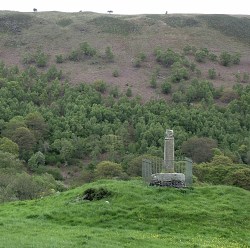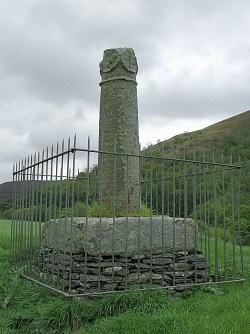Supplement
Eliseg’s Pillar


Eliseg’s Pillar, sited to the north-west of Llangollen, is the remnant of a cross that was erected, on top of a Bronze Age cairn, by Concenn, i.e. Cyngen, king of Powys, who died at Rome in 854, in memory of his great-grandfather Eliseg (Elise). By 1696, when the antiquarian Edward Lhuyd visited the site, the monument had been toppled – possibly in the 1640s, during the Civil Wars. Its upper stonework, the cross itself, was gone. What Lhuyd found was: “a stately pillar of very hard stone … ’Twas of a cylinder form, above 12 foot in height … broke in several pieces”. He transcribed as much as he could discern of the pillar’s 31 lines of Latin inscription.[*] In 1779 a local landowner, one T. Lloyd, mounted the eight-foot long stump that by then remained – the upper section of the cylindrical pillar, with a moulded collar and swags forming the transition to the cross’ rectangular-sectioned shaft – into the original base-stone, in its original position, though, presumably to improve the, now much reduced, pillar’s visibility, Lloyd had a drystone plinth built beneath the base. He also added a new Latin inscription, on the other side of the pillar to the original inscription, recording the monuments restoration. This remnant’s 15 lines of original inscription have been more or less illegible for many years,[*] so the following interpretation is necessarily wholly based on Edward Lhuyd’s transcription:
+ Concenn son of Cattell, Cattell son of Brohcmail, Brohcmal son of Eliseg, Eliseg son of Guoillauc.
+ Concenn therefore, great-grandson of Eliseg, erected this stone for his great-grandfather Eliseg.
+ It was Eliseg who united the inheritance of Powys … however through force … from the power of the English … land with his sword by fire(?).
[+] Whosoever shall read out loud this hand-inscribed … let him give a blessing [on the soul of] Eliseg.
+ It is Concenn … with his hand … his own kingdom of Powys … and which … the mountain.
… monarchy … Maximus of Britain … Pascent … Maun Annan … Britu moreover [was] the son of Guarthigirn whom Germanus blessed [and whom] Sevira bore to him, the daughter of Maximus the king, who killed the king of the Romans.
+ Conmarch represented pictorially this writing at the demand of his king, Concenn.
+ The blessing of the Lord upon Concenn and likewise(?) on all of his household and upon all the province of Powys until … .